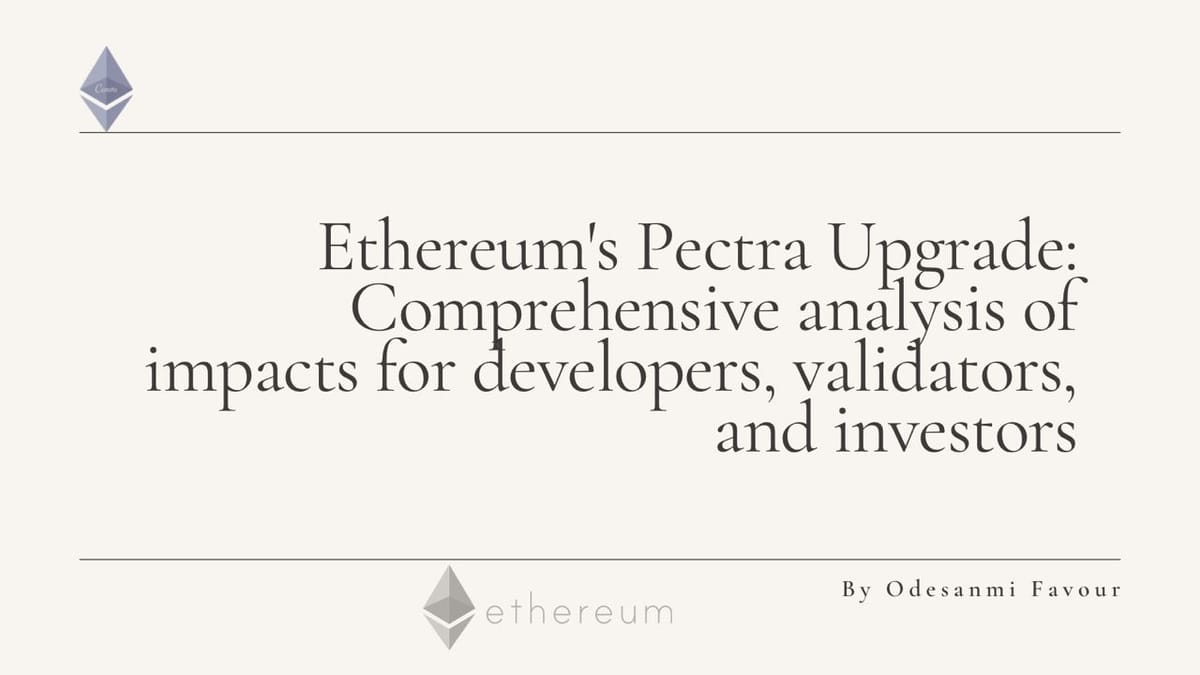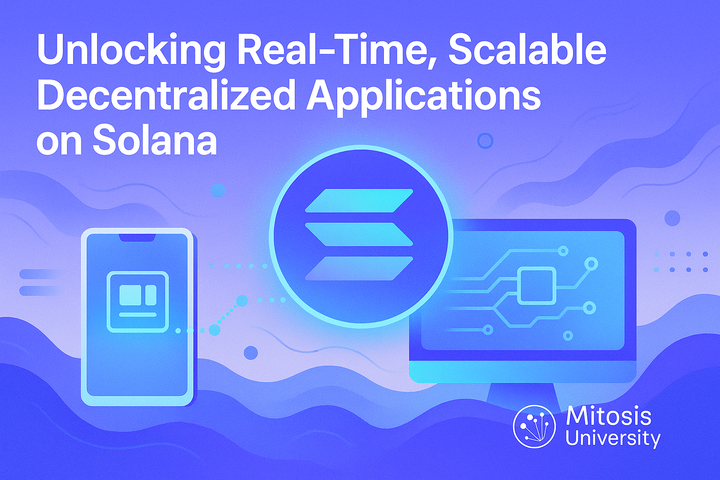Ethereum's Pectra Upgrade: Comprehensive Analysis of Impacts for Developers, Validators, and Investors

Introduction
The Ethereum blockchain, a cornerstone of decentralized applications and smart contracts, is set to undergo its most ambitious upgrade yet with the Pectra upgrade, scheduled for mainnet activation on May 7, 2025. Combining the Prague (execution layer) and Electra (consensus layer) upgrades, Pectra introduces 11 Ethereum Improvement Proposals (EIPs) aimed at enhancing scalability, validator efficiency, user experience, and security. This upgrade builds on the successes of The Merge (2022) and Dencun (2024), positioning Ethereum to compete with faster blockchains like Solana and Sui while reinforcing its dominance in the Layer 2 (L2) ecosystem.
In this article, we would explore:
1. Impacts on Developers: New Tools and Enhanced Functionality
2. Impacts on Validators: Improved Staking Efficiency and Flexibility
3. Impacts on Investors: Market Opportunities and Risks
Impacts on Developers: New Tools and Enhanced Functionality
The Pectra upgrade equips developers with advanced tools to build more efficient, user-friendly, and scalable decentralized applications (dApps). Key EIPs introduce features like account abstraction, improved cryptographic operations, and enhanced data availability, enabling developers to create innovative solutions for DeFi, gaming, and NFTs.
Key Changes for Developers
1. EIP-7702: Account Abstraction
This EIP allows Externally Owned Accounts (EOAs) to temporarily execute smart contract logic during transactions, enabling features like transaction batching, gas sponsorship, and alternative key schemes. For example, users can pay gas fees with ERC-20 tokens like USDC instead of ETH, simplifying wallet interactions. Developers can integrate these features into dApps, reducing user friction and enhancing mainstream adoption.
For Example: A DeFi protocol can batch token approvals and swaps into a single transaction, lowering gas costs and improving user experience.
2. EIP-7691: Blob Throughput Increase
Building on EIP-4844 (introduced in Dencun), Pectra doubles the blob capacity from three to six per block (768 kilobytes). This enhances L2 rollup scalability, reducing transaction fees and enabling developers to build high-throughput dApps. For instance, rollups like Arbitrum and Optimism can process more transactions, making Ethereum more competitive with faster chains.
For Example: A gaming dApp on Optimism can handle thousands of in-game transactions per second at lower costs, attracting more users.
3. EIP-2537: BLS12-381 Precompile
This EIP introduces a precompile for BLS12-381 curve operations, reducing the computational cost of cryptographic tasks. Developers building zero-knowledge (ZK) applications, such as ZK-rollups or privacy-focused dApps, benefit from faster and cheaper signature verification.
For Example: A ZK-based voting dApp can verify thousands of encrypted votes on-chain efficiently, ensuring privacy and scalability.
Preparation Strategies
Developers should test their dApps on testnets like Sepolia and Holesky to ensure compatibility with Pectra’s changes. Updating smart contracts to leverage EIP-7702’s account abstraction and optimizing for blob-based data storage can position projects for success. However, developers must monitor testnet stability, as issues like Sepolia’s empty block production highlight potential risks.
Impacts on Validators: Improved Staking Efficiency and Flexibility
Validators, responsible for securing Ethereum’s Proof-of-Stake (PoS) network, will see significant operational improvements with Pectra. EIPs like EIP-7251 and EIP-7002 streamline staking, reduce network overhead, and enhance security, benefiting both solo stakers and institutional operators.
Key Changes for Validators
1. EIP-7251: Maximum Effective Balance Increase**
This EIP raises the maximum effective balance for validators from 32 ETH to 2,048 ETH, allowing validators to earn rewards on larger stakes without running multiple nodes. It also enables consolidation of existing validators, reducing the total validator count (currently over 1 million) and alleviating network congestion. Solo stakers benefit from compounding rewards, while large operators simplify their setups.
For Example: A validator with 128 ETH can now stake it all under one node instead of four, reducing hardware costs and attestation load.
2. EIP-7002: Execution Layer Withdrawals
Validators can now trigger withdrawals and exits from the execution layer using withdrawal credentials, reducing reliance on vulnerable active keys. This enhances security and flexibility, especially for staking pools and institutional operators.
For Example: A staking provider like Blockdaemon can securely manage client withdrawals without exposing active keys, minimizing risks.
3. EIP-7549: Reduced Attestation Overhead. By removing the committee index from attestation messages, this EIP reduces the number of BLS signatures required by a factor of 64, lowering validator bandwidth and processing demands. This improves consensus efficiency and supports validators on low-grade hardware.
For Example: A solo staker in a region with limited internet can maintain validator duties more reliably, enhancing decentralization.
Preparation Strategies
Validators should update their client software (e.g., Geth, Nethermind) and withdrawal credentials to 0x02 to opt into the new maximum effective balance. Testing on the Hoodi testnet, which successfully finalized Pectra, is critical to avoid issues seen on Holesky and Sepolia. Validators must also weigh the risks of consolidation, as higher balances increase slashing penalties, though reduced to 1/4,096 of the effective balance.
Impacts on Investors: Market Opportunities and Risks
For investors, Pectra’s technical improvements could drive long-term adoption and price appreciation, but short-term volatility and competitive pressures require caution. The upgrade’s focus on scalability, staking efficiency, and user experience may attract institutional and retail interest, while risks like testnet issues and L2 competition loom.
Key Impacts for Investors
1. Scalability and L2 Revenue Potential
The blob throughput increase (EIP-7691) enhances L2 scalability, reducing fees and making Ethereum more attractive for DeFi, gaming, and NFT applications. This could drive user activity and ETH demand, as L2s like Base, Optimism, and Arbitrum capture more revenue for the mainnet. However, if blob capacity remains insufficient for 2025’s rollup boom, some L2s may opt for alternatives like Celestia, reducing Ethereum’s data availability revenue.
For Example: Increased activity on Arbitrum could boost ETH staking demand, as more ETH is locked to secure the network, potentially supporting price stability.
2. Staking Incentives and Supply Dynamics
EIP-7251 and EIP-7002 make staking more flexible and secure, potentially attracting more ETH to be staked (currently ~28% of total supply). Higher validator rewards and lower slashing penalties could increase staking participation, reducing circulating supply and supporting price stability. Institutional investors may accumulate ETH to stake up to 2,048 ETH efficiently.
For Example: CryptoQuant analysts noted large-scale ETH accumulation at undervalued price levels (MVRV ~1), signaling institutional confidence in Pectra’s impact.
Market Sentiment and Risks
Historically, major upgrades like The Merge and Dencun generated market hype, and Pectra’s May 7 launch could act as a catalyst. As of February 2025, ETH traded around $2,711, up 10% in a day, reflecting optimism. However, testnet issues (e.g., Holesky’s failure to finalize) fueled bearish sentiment, with ETH dropping 3% in early March 2025. Investors should monitor mainnet stability post-launch to assess risks.
Investment Considerations
Investors should evaluate ETH’s price potential against competitive pressures from faster blockchains like Solana. While Pectra strengthens Ethereum’s L2 ecosystem, the PeerDAS upgrade in 2026 will be critical for long-term scalability. Diversifying into L2 tokens (e.g., ARB, OP) may hedge risks if Ethereum’s data availability revenue declines. Always conduct thorough research, as cryptocurrencies carry high volatility.
Conclusion
The Pectra upgrade marks a pivotal moment for Ethereum, addressing scalability, validator efficiency, and user experience through 11 carefully crafted EIPs. Developers gain powerful tools like account abstraction and blob-based scaling to build innovative dApps. Validators benefit from streamlined operations and enhanced security, encouraging broader participation. Investors face opportunities for price appreciation driven by increased adoption and staking demand, tempered by risks from testnet challenges and L2 competition.
As Ethereum prepares for its May 7, 2025, mainnet launch, stakeholders must stay proactive. Developers should test rigorously, validators should update infrastructure, and investors should monitor market dynamics. By addressing these changes strategically, the Ethereum ecosystem can solidify its position as the leading smart contract platform, paving the way for mass adoption and long-term growth



Comments ()